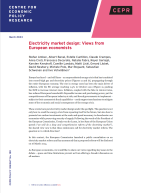The authors support the consensus that maintaining short-term electricity markets is important for promoting production efficiency and efficient consumption. However, these are volatile, do not reflect the average costs of different generation technologies, and fail to convey effective market signals for long-term investments. A priority of the market redesign should be to facilitate healthy long-run contracting arrangements capable of addressing these concerns.
Long-term contracts for both producers and consumers are at the core of electricity market reform and should safeguard against cost and revenue fluctuations, whilst also promoting lower electricity prices and encouraging participation in short-term markets. Skillfully designed long-term contracts have the potential to enhance the efficiency of short-term markets by minimising risks related to regulatory interventions or technological advancements, reducing the temptation for market manipulation, and allowing for greater market entry and participation.
The debate on how to strengthen long-term contracting in electricity markets revolves around two options: power purchasing agreements (PPAs) and auctions for contracts for differences (CfDs), run by regulators. The authors stress that it is incorrect to assume that only PPAs are market-based solutions and that CfDs involve state support and should only be used when the market fails, as these misconceptions could bias the assessment of organising long-term contracting in electricity markets.
The limitations of PPAs in renewable energy markets include opacity, potential failure to pass on savings to end-users, and negative effects on the liquidity of short-term energy markets. The authors also point to the limited scale of long-term PPAs that utilities and energy-intensive industries can underwrite because of the risks involved in holding such PPAs as open positions in their books. However, PPAs can provide contracting options for firms, flexibility in contract terms, and investment opportunities to back, for example, live time extensions in renewable energy assets. The authors recommend regulatory-backed auctions for CfDs as a more effective mechanism to deliver renewable energy projects, unlock investments, and reduce counterparty risks. CfD auctions can be designed to reward system-friendly production profiles, avoid inframarginal rents, and promote competitive outcomes for end-users.
The authors also discuss the revenues of existing inframarginal generators such as nuclear, hydro, and renewables, which have been making enormous profits at the cost of energy consumers due to high market prices despite having low production costs. They suggest that options to limit excessive revenues agreed at the European level should be maintained as a safety valve to avoid challenges emerging from extreme market conditions in the future. Any such limitations should be implemented without distorting the marginal signal for relevant price ranges in the wholesale market and should be high enough not to affect normal business conditions.
Overall, the authors support the need to reform the electricity market in order to address high and volatile electricity prices and promote the Energy Transition. However, they advise caution in relying solely on PPAs for low-carbon investments and suggest boosting the use of regulatory-backed auctions of contracts for differences. This would encourage investment, competition, and lower electricity prices for all consumers. However, the interaction between the two instruments still needs to be defined and this is therefore a challenge for market design.



